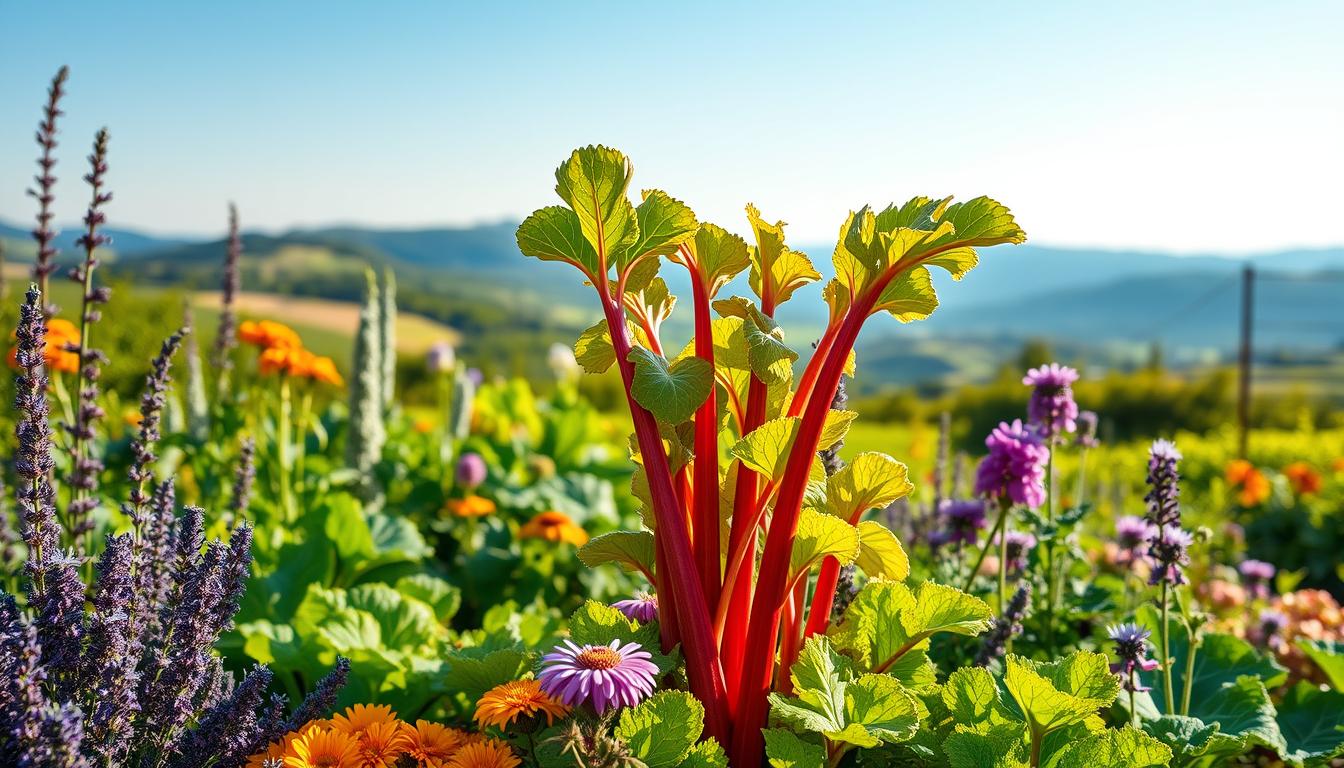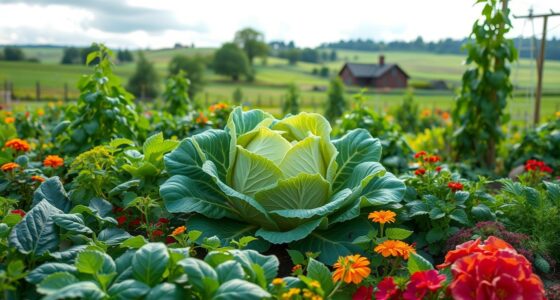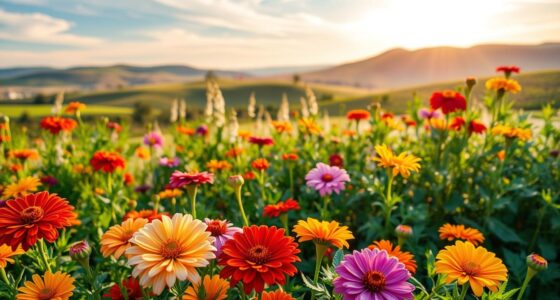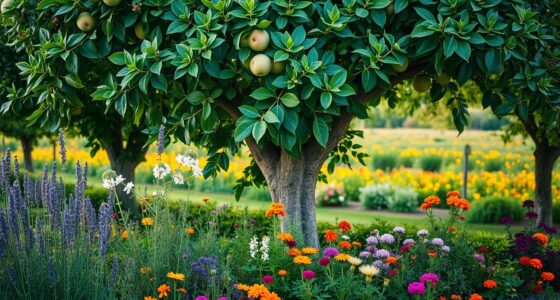Imagine stepping into your garden, a sense of pride swelling within you as you survey the vibrant greenery thriving under the sun. Gardeners know instinctively that each plant plays its part in this delicate ecosystem, but have you considered how rhubarb companion plants can amplify the beauty and yield of your garden? By selecting the best companion plants for rhubarb, you’re not just planting alongside each other—you’re creating a symbiotic relationship that nurtures growth and deters pests. This rhubarb companion planting guide will illuminate the path to a more fruitful and harmonious garden, making your efforts rewarding and sustainable. Let’s uncover the secrets that will enhance the life of your beloved rhubarb.
Key Takeaways
- Understanding companion planting helps you create a balanced garden ecosystem.
- Rhubarb thrives with specific plants, boosting growth and pest resistance.
- Strategically chosen companions can enhance the flavor and health of your rhubarb.
- Soil health and sunlight requirements are crucial for optimal growth.
- Engaging with your community can enrich your gardening experience.
Understanding the Benefits of Companion Planting
Companion planting involves the strategic placement of different plant species in close proximity to each other to promote mutual benefits. This practice enhances the garden’s ecosystem, improving plant health, pest resistance, and yield. For those cultivating rhubarb, understanding the benefits of companion plants for rhubarb is key. By choosing the right companions, you can create a thriving environment for your rhubarb, ensuring it flourishes while also enhancing your garden’s overall productivity.
What is Companion Planting?
Companion planting is a gardening technique that pairs different plants to maximize their growth benefits. Various plant combinations can deter pests, enhance nutrient uptake, and even improve flavor. This method not only supports plant health but also enriches the soil through diverse root structures and organic matter. Utilizing companion planting sets the stage for a vibrant and sustainable garden.
Why Choose Companion Plants for Rhubarb?
Choosing companion plants for rhubarb provides multiple advantages. Here are some of the primary benefits:
- Repelling harmful pests that threaten rhubarb’s health.
- Attracting beneficial insects, such as pollinators, to your garden.
- Enhancing soil quality and structure, leading to improved rhubarb growth.
- Creating a balanced ecosystem that supports overall garden vitality.
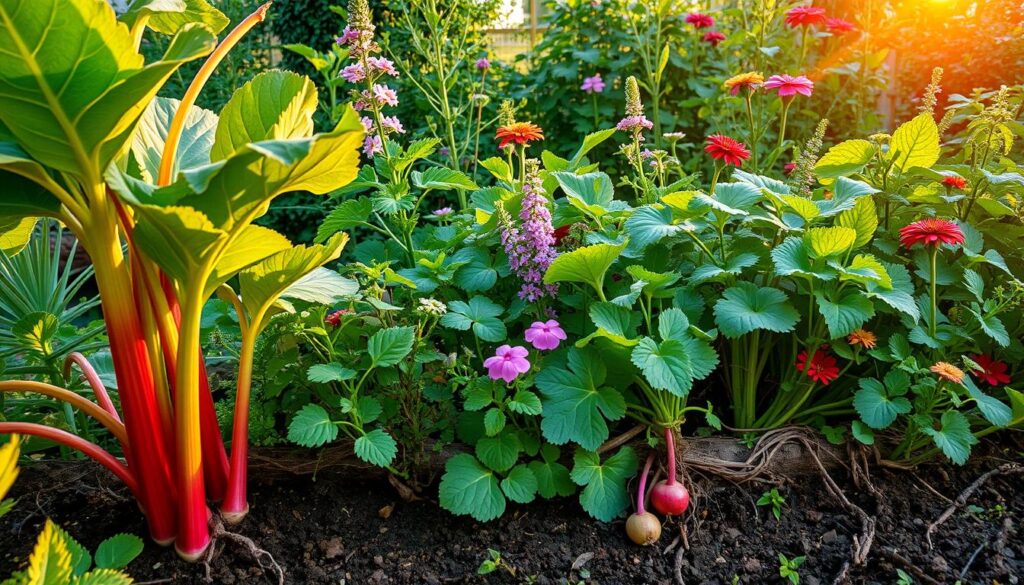
With these insights, you can take intentional steps to select the best companion plants for your rhubarb, ensuring both yield and health for your garden endeavors.
Ideal Companion Plants for Rhubarb
Choosing the right rhubarb garden companions can significantly enhance the growth and health of your rhubarb plants. Selecting the best companion plants for rhubarb not only supports its development but also contributes to an overall thriving garden ecosystem. Exploring various herbs and vegetables that flourish alongside rhubarb sheds light on effective gardening practices.
Herbs that Pair Well with Rhubarb
Integrating herbs into your rhubarb garden can provide benefits beyond aesthetic appeal. Certain herbs contribute to pest deterrence and soil enrichment.
- Garlic: Known for its strong aroma, it helps repel aphids and other pests, ensuring your rhubarb remains healthy.
- Onions: Similar to garlic, onions serve as a natural pest repellent and can enhance nutrient availability in the soil.
- Chives: These herbs not only deter aphids but also attract beneficial insects, creating a more balanced environment.
Vegetables that Support Rhubarb Growth
Alongside herbs, specific vegetables serve as ideal companions for rhubarb, enhancing its growth through various interactions.
- Strawberries: They thrive in similar soil conditions and can provide shade, helping to maintain moisture levels around rhubarb.
- Beans: These legumes enrich the soil with nitrogen, benefiting rhubarb while simultaneously utilizing vertical space effectively.
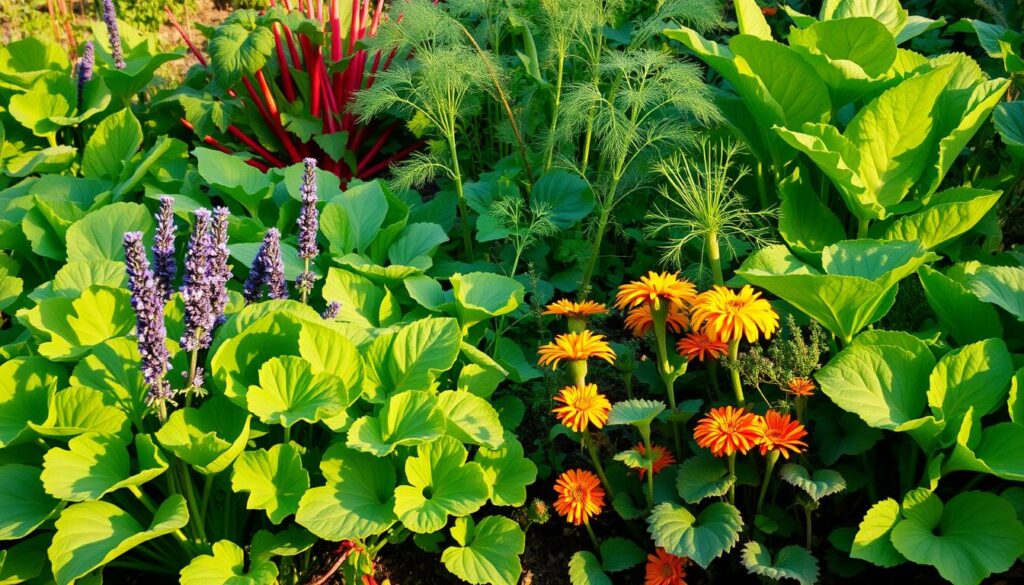
| Companion Plants | Benefits |
|---|---|
| Garlic | Repels pests, enhances soil health |
| Onions | Pest deterrent, nutrient enhancer |
| Chives | Attracts beneficial insects, pest repellent |
| Strawberries | Provides shade, moisture retention |
| Beans | Adds nitrogen, optimizes vertical space |
By understanding the relationships between rhubarb and its companions, you can foster a more productive and enjoyable gardening experience. Implementing these practices will lead you to discover the full potential of your rhubarb plants.
Plants to Avoid with Rhubarb
While incorporating companion plants for rhubarb bed can enhance growth and health, some plants are best left out of your rhubarb garden. Knowing which plants to avoid near rhubarb helps you maintain a thriving environment.
Companions That Hinder Rhubarb Growth
Several common garden plants compete with rhubarb for nutrients and can impede its development. For instance, potatoes and tomatoes are notorious for drawing essential resources from the soil, which can leave rhubarb lacking in necessary sustenance. This nutrient competition makes them undesirable neighbors for your rhubarb.
Plants That Attract Pests to Rhubarb
Some plants not only hinder growth but also attract pests that pose a threat to rhubarb. Sunflowers are one such example. While they can add beauty to your garden, they are known to attract pests like aphids, which can damage your rhubarb. By identifying these plants to avoid near rhubarb, you can create a healthier growing space and minimize pest issues.

Creating the Perfect Growing Conditions for Rhubarb
Establishing optimal conditions is crucial when growing rhubarb with companions. This plant flourishes in specific soil and lighting conditions. Understanding these requirements sets the stage for robust growth and vibrant garden life. Attention to detail ensures that your rhubarb garden partners thrive alongside this unique perennial.
Soil Requirements for Rhubarb
The foundation of a successful rhubarb garden lies in soil quality. Rhubarb prefers well-draining soil that is slightly acidic, ideally with a pH of 5.5 to 6.8. Incorporating organic matter, such as compost, boosts soil fertility and enhances its structure. Below is a table summarizing essential soil characteristics:
| Soil Characteristic | Ideal Condition |
|---|---|
| Drainage | Well-draining |
| pH Level | 5.5 – 6.8 (slightly acidic) |
| Organic Matter | High percentage, preferably 30% or more |
Sunlight and Watering Needs
Rhubarb thrives in full sun but can tolerate partial shade, especially in hotter climates. Aim for at least six hours of direct sunlight daily to maximize growth and maintain the health of your rhubarb garden partners. Regular watering is equally vital. Rhubarb requires consistent moisture, particularly during the growing season, to prevent stress and support active growth. Here are some watering tips:
- Always check the top inch of soil; if dry, it’s time to water.
- Water deeply but infrequently to encourage strong root systems.
- Mulch around the base to maintain soil moisture and regulate temperature.
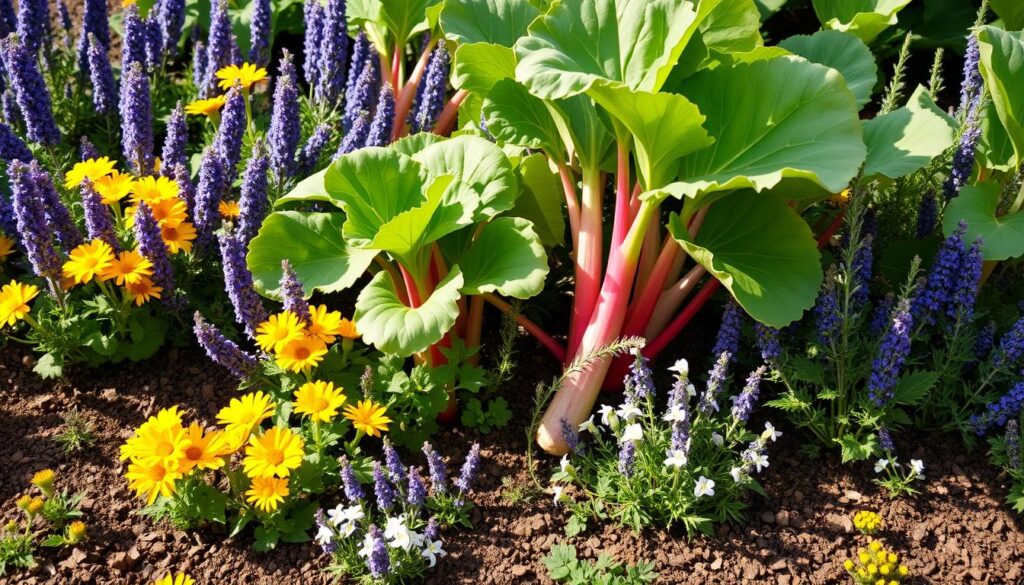
Incorporating Companion Plants into Your Garden Layout
When designing your garden layout, consider how different plants can harmonize with one another. Implementing rhubarb companion planting ideas can enhance both aesthetics and productivity. Thoughtful planning makes a significant difference, promoting healthy growth and reducing resource competition. For example, low-growing plants often benefit from the shade provided by taller plants like rhubarb.
Planning Your Garden Design
Start by sketching out your garden space, marking where you plan to place various plants. Include both rhubarb and its companion plants in your design. Some effective companion plants for rhubarb bed include strawberries, which thrive in the partial shade offered by rhubarb. This kind of layering not only creates a visually appealing layout but also optimizes space. Consider using a mix of colors and textures to make your garden vibrant and diverse.
Spacing and Arrangement Tips
Proper spacing is crucial for the well-being of your plants. Allow sufficient space between each plant to promote airflow and nutrient uptake. Here are some essential tips:
- Plant rhubarb at a distance of 3 feet apart to allow ample room for growth.
- Position shorter plants like strawberries or herbs around the base of rhubarb.
- Maintain a balance between taller and shorter plants to maximize sunlight exposure.
| Companion Plant | Benefits |
|---|---|
| Strawberries | Thrives in partial shade and complements rhubarb well. |
| Chives | Repels pests and attracts beneficial insects. |
| Marigolds | Deters nematodes and adds color to your garden. |
| Garlic | Helps suppress harmful pests and provides a culinary bonus. |
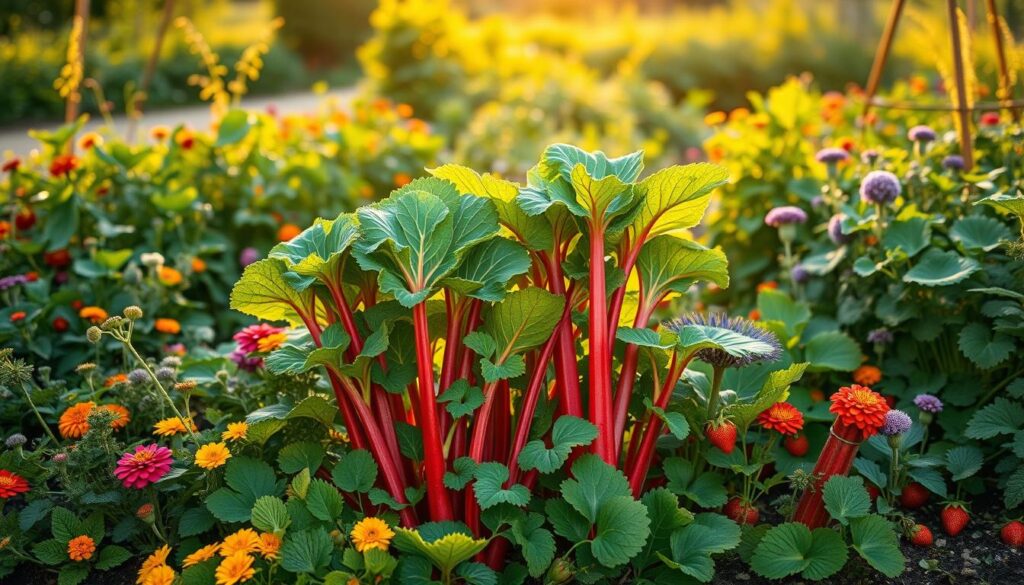
Seasonal Planting Considerations for Rhubarb
Understanding the seasonal aspects of planting rhubarb can significantly enhance your gardening experience. The timing of planting plays a critical role in establishing healthy roots. Spring presents the best opportunity to plant rhubarb, allowing the roots to become well-established before the heat of summer sets in. With a thoughtful approach, you can turn these seasonal companion planting ideas into effective strategies for a thriving garden.
Best Time to Plant Rhubarb
Rhubarb benefits greatly from being planted in early spring. This timing ensures that the plants can take full advantage of the cooler weather for root development. Ensuring that you plant them after the last frost will protect the young plants from damage. A healthy start in spring will pave the way for vigorous growth during the growing season.
Seasonal Companion Planting Ideas
Incorporating seasonal companion plants can greatly support rhubarb’s growth journey. In spring and summer, consider planting beans alongside your rhubarb. Beans add nitrogen to the soil, enriching conditions for rhubarb to flourish. Conversely, some plants may be best suited for fall planting, aligning their growth with the changing seasons. Understanding these dynamics will help you optimize your rhubarb companion planting guide for a successful yield.
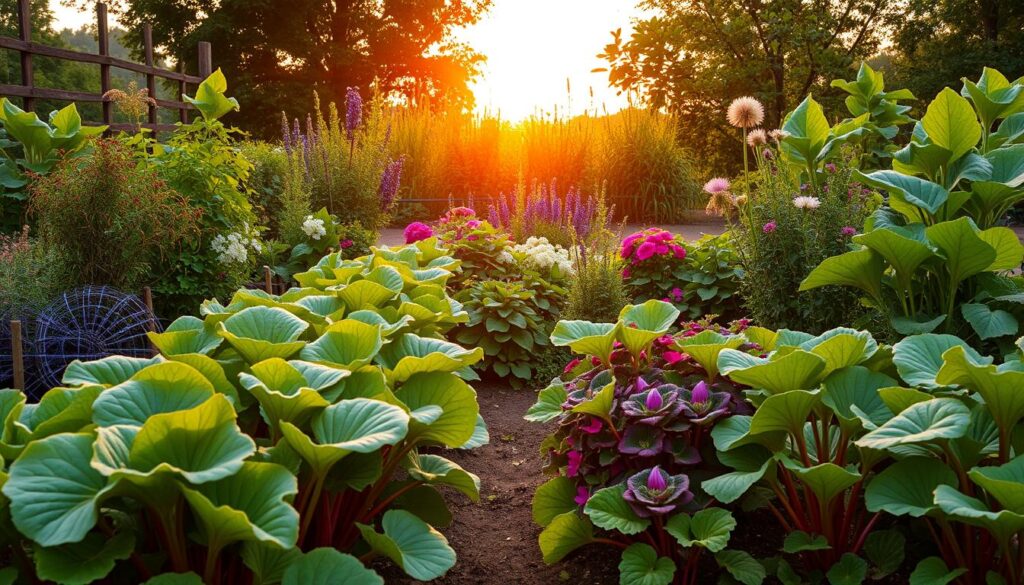
Companion Plants for Pest Management
Using companion plants can significantly enhance your garden’s overall health, particularly when it comes to managing pests. Integrating certain plants alongside your rhubarb can create a harmonious environment where natural pest deterrents thrive. This strategy relies on attracting beneficial insects that will help keep harmful pests at bay.
Using Companion Plants to Deter Pests
Companion plants serve as excellent rhubarb pest deterrents. For example, planting marigolds nearby not only beautifies your garden but also repels aphids and nematodes. Other herbs, like basil and catnip, can lure in pollinators and predatory insects like ladybugs, which feast on unwanted pests. This natural pest management with companion plants fosters a thriving ecosystem around your rhubarb, minimizing the need for chemical pesticides.
Natural Predators and Their Role
Natural predators play a crucial role in pest management. By attracting these helpful insects, you reinforce your garden’s defenses. For instance, parasitic wasps can keep caterpillar populations in check, while lacewings target a range of soft-bodied pests. A diverse planting strategy that promotes these beneficial insects can help maintain a balance in your garden, ensuring that your rhubarb remains healthy and productive.
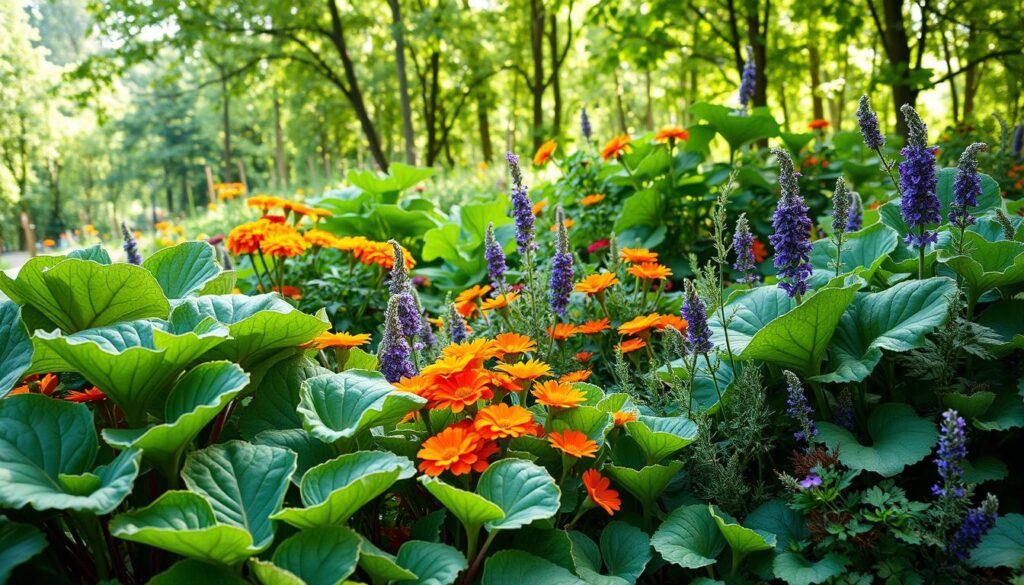
Enhancing Flavor with Companion Plants
Growing rhubarb alongside certain plants can significantly improve its taste and overall quality. A thoughtful selection of companion plants can lead to enhanced rhubarb flavor that elevates your culinary experience. Consider incorporating culinary herbs for rhubarb, as these can offer delightful flavor pairings while attracting beneficial insects.
How Companion Plants Can Improve Rhubarb Taste
Integrating specific herbs into your rhubarb garden creates a symbiotic relationship that benefits both plants. For example, mint can offer a refreshing contrast to rhubarb’s tartness, making dishes more exciting. Furthermore, basil brings a distinct aromatic quality, enhancing the profile of any rhubarb-based recipe. Not only do these companions enhance flavor, but they can also drive away unwanted pests, allowing your rhubarb to thrive.
Culinary Herbs to Consider
- Mint: A vibrant herb that adds a unique twist to rhubarb dishes.
- Basil: Its sweet flavor complements rhubarb’s tartness beautifully.
- Thyme: This herb provides earthy notes that balance rhubarb’s tang.
- Chives: Their mild onion flavor offers a delightful enhancement.
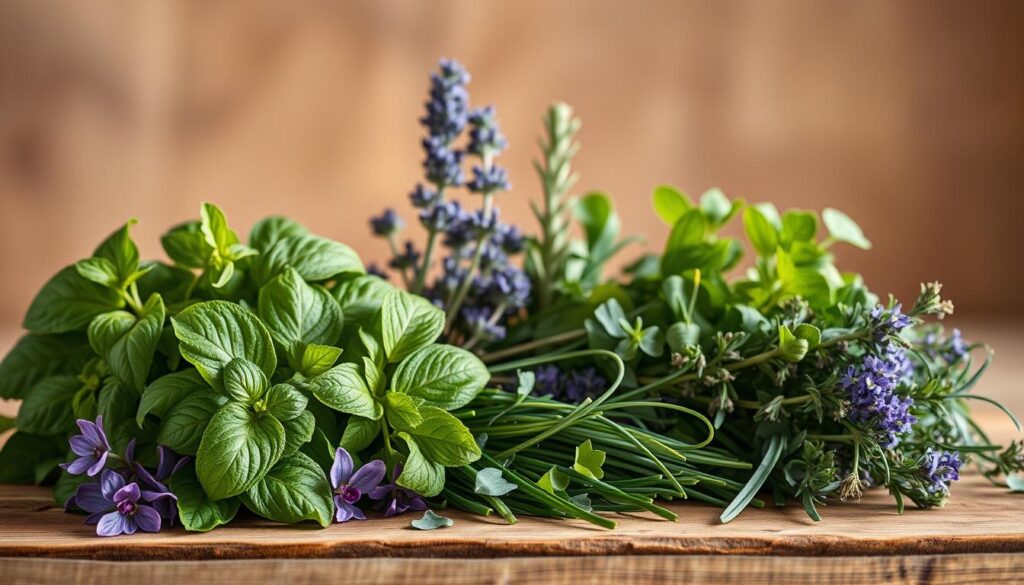
Maximizing Your Space with Vertical Gardening
Vertical gardening techniques offer an innovative way to enhance your garden space, especially when working with rhubarb. This method allows you to cultivate plants upward, maximizing limited areas while promoting healthy growth. By selecting the best climbing companion plants, you can optimize your garden’s productivity without overcrowding the soil.
Vertical Gardening Techniques with Rhubarb
When employing vertical gardening with rhubarb, consider using trellises or other supports. These structures elevate climbing plants, allowing them to thrive alongside your rhubarb. This arrangement not only beautifies your garden but also ensures optimal sunlight exposure and air circulation, key factors that contribute to plant health. Utilizing containers or vertical planters can also be effective, especially in urban settings where space is at a premium.
Best Climbing Companion Plants
Choosing the right climbing companion plants can significantly enhance your garden’s output. Ideal options include:
- Peas – Their nitrogen-fixing properties benefit rhubarb’s growth.
- Beans – These also contribute nitrogen and grow well while climbing.
- Cucumbers – They take advantage of vertical space, leaving room for rhubarb below.
- Tomatoes – When planted with caution, they can share vertical space without affecting rhubarb’s health.
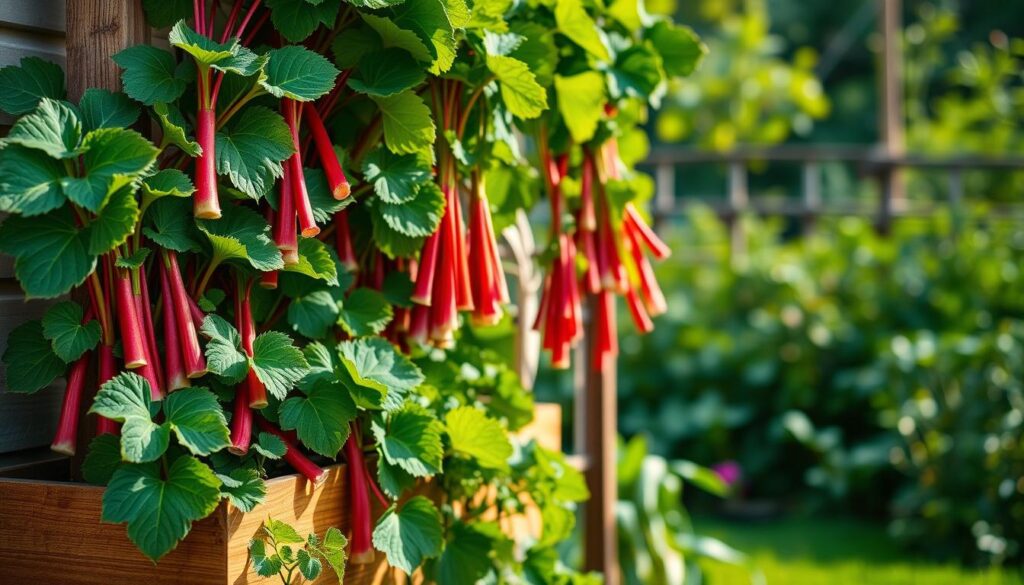
Integrating these plants into your vertical garden will create a flourishing environment, enhance yields, and make the most of your available space. With careful planning and the right companion choices, your rhubarb can thrive amidst a vibrant array of climbing plants.
Harvesting Tips for Rhubarb and Companion Plants
Harvesting rhubarb and its companion plants requires attention to timing and technique for the best results. Following proper rhubarb harvesting tips will ensure healthy yields, while effectively managing companion plant harvesting contributes to your garden’s overall success.
When and How to Harvest Rhubarb
Wait until the third year after planting before you attempt a full harvest of rhubarb. This allows the plant to establish a strong root system. When the stalks are at least 12 inches long and have a vibrant color, they are ready to be harvested. To detach them cleanly, grasp the base of the stalk and twist gently. Avoid cutting, as this may leave part of the stalk on the plant, which can lead to rot.
Harvesting Companion Plants Effectively
Timing is crucial for companion plant harvesting. It’s essential to monitor their growth habits and harvest them at peak ripeness. Each type of companion plant has specific signs of readiness, so familiarize yourself with these indicators for optimal quality. Whether you are picking herbs or vegetables, follow best practices to ensure the health of the remaining plants in your garden.

Evaluating Plant Health in Your Garden
Keeping a close eye on your garden’s plant health is essential for thriving growth. Both rhubarb and its companion plants have distinct signs that indicate their well-being. Knowing what to look for can help you maintain a robust garden, allowing you to enjoy healthy plants and a bountiful harvest.
Signs of Thriving Plants
When evaluating plant health, observe your garden for lush, green foliage and sturdy stems. Healthy rhubarb plants typically exhibit vibrant leaf colors and vigorous growth. Look for the following signs:
- Deep green leaves: This color indicates that your plants are receiving adequate nutrients.
- Strong structure: Sturdy stems suggest good support and energy for the plant.
- Dense foliage: A well-covered area indicates healthy growth and effective sunlight absorption.
Identifying and Addressing Plant Issues
Keeping your garden healthy involves recognizing potential issues before they escalate. Common plant issues in rhubarb gardens may include:
- Yellowing leaves: This can indicate nutrient deficiencies or overwatering.
- Stunted growth: Often caused by poor soil quality or inadequate light.
- Pest infestations: Look for any signs of pests that could harm your plants.
By carefully monitoring these factors, you can take prompt action to mitigate any issues, ensuring the overall health of your garden.
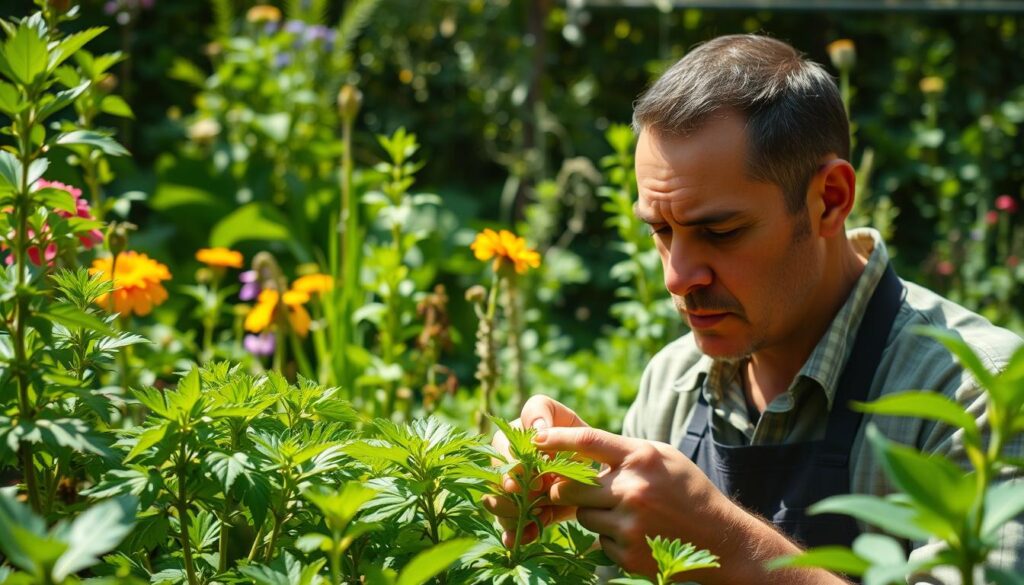
| Signs of Thriving Plants | Potential Issues |
|---|---|
| Deep green leaves | Yellowing leaves |
| Strong structure | Stunted growth |
| Dense foliage | Pest infestations |
Sustainable Gardening Practices with Rhubarb
Engaging in sustainable gardening with rhubarb not only benefits the environment but also enhances the flavor and quality of your homegrown produce. By opting for organic fertilization for rhubarb, you allow nature to thrive while ensuring a healthy garden. Utilizing organic methods creates a chemical-free ecosystem, fostering biodiversity and encouraging beneficial insects.
Organic Fertilizers for Rhubarb and Companions
Organic fertilizers play a crucial role in sustaining rhubarb. Options such as well-rotted manure, compost, and bone meal provide essential nutrients without harmful additives. These organic solutions feed your soil and plants, promoting a thriving environment. Combining these fertilizers with companion plants can amplify their effects and enrich the soil further through *nutrient cycling*.
Soil Health and Companion Plant Benefits
Healthy soil is fundamental to achieving productive gardening. Companion plants help to improve soil structure by increasing the organic matter content. As you incorporate diverse plants into your garden, they contribute to improved drainage and aeration. Practices like composting and rotating crops can enhance the benefits of companion planting, resulting in a garden that’s not only beautiful but sustainably productive.
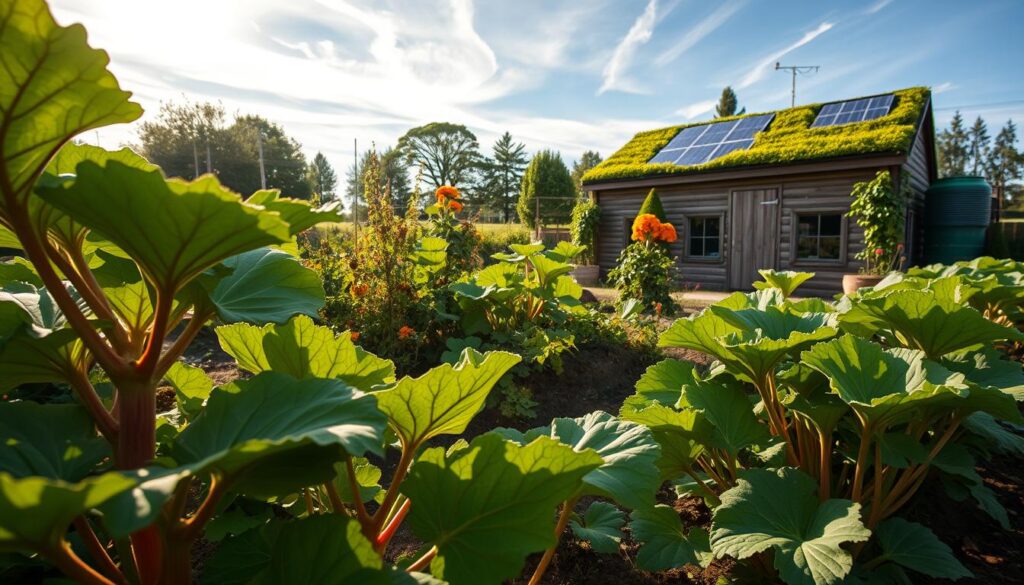
Engaging Your Community in Companion Planting
Bringing your community together through gardening can create a vibrant exchange of ideas and experiences. Engaging in community gardening allows you to share your passion for rhubarb companion plants while fostering sustainable practices. You can inspire others to explore the benefits of companion planting through open discussions and collaborative efforts.
Sharing Your Experience with Neighbors
Building connections with neighbors while sharing companion planting experiences enhances the gardening community. You may consider organizing regular meetups where individuals can discuss their successes and challenges. This setup promotes a sense of belonging and encourages collective problem-solving. Sharing information about suitable companion plants for rhubarb, such as herbs and vegetables, can lead to improved gardening strategies.
Organizing a Community Gardening Event
Hosting a community gardening event serves as an excellent opportunity for collective learning and growth. You can invite experts to talk about the benefits of companion planting and provide hands-on workshops. These events allow participants to see firsthand the advantages of integrating different plants with rhubarb, enhancing both productivity and community spirit. Setting aside time for group planting or garden walks can make your event even more engaging for everyone involved.
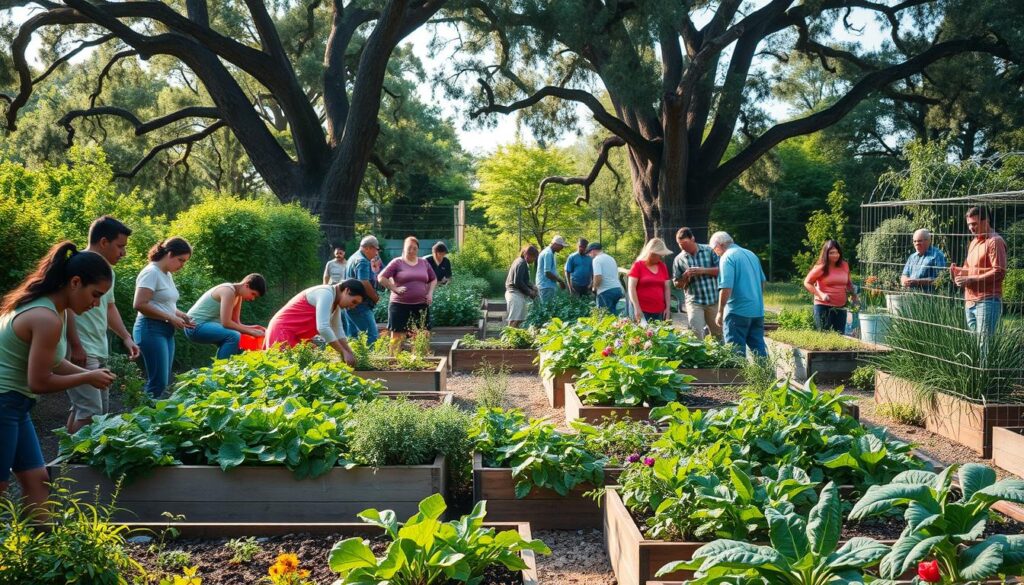
Resources for Further Learning on Rhubarb and Companion Plants
If you’re looking to deepen your understanding of rhubarb gardening resources, there are plenty of avenues to explore. Various books dedicated to organic gardening and companion planting can provide essential insights. Notable titles such as “Carrots Love Tomatoes” by Louise Riotte and “The Companion Planting Resource Book” by Susan McClure are must-reads that guide you through the intricacies of pairing plants effectively.
In addition to literature, numerous reputable gardening websites are packed with tips and articles about growing rhubarb and its companions. Platforms such as the Botanical Society of America or the Old Farmers’ Almanac feature extensive information and guides that can boost your gardening proficiency. These sources serve as excellent references for further learning on companion plants, helping you achieve a thriving garden.
Moreover, engaging in local workshops and joining gardening clubs can dramatically enhance your growing experience. Community gardening sessions allow you to exchange knowledge and practical skills with fellow gardening enthusiasts. Many local botanical gardens and cooperative extension offices organize events that offer hands-on activities to help you get the most out of your rhubarb and companion plants. By tapping into these resources, you’re set to cultivate a more flourishing garden.
